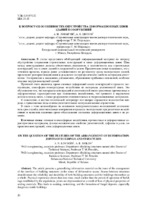| dc.contributor.author | Ловыгин, А. Н. | ru |
| dc.contributor.author | Шилов, А. Е. | ru |
| dc.coverage.spatial | Минск | ru |
| dc.date.accessioned | 2023-12-13T07:30:39Z | |
| dc.date.available | 2023-12-13T07:30:39Z | |
| dc.date.issued | 2023 | |
| dc.identifier.citation | Ловыгин, А. Н. К вопросу об особенностях обустройства деформационных швов зданий и сооружений = On the question of the features of the arrangement of deformation joints of buildings and structures / А. Н. Ловыгин, А. Е. Шилов // Проблемы современного строительства [Электронный ресурс] : сборник научных трудов, Минск, 23 мая 2023 г. / редкол.: В. В. Бондарь, В. Ф. Зверев, Е. А. Козловский. – Минск : БНТУ, 2023. – С. 20-24. | ru |
| dc.identifier.uri | https://rep.bntu.by/handle/data/138406 | |
| dc.description.abstract | В статье представлен обобщающий информационный материал по вопросу обустройства сопряжения строительных конструкций в зонах деформационных швов. Швы между конструкциями должны обеспечивать надежность и долговечность как строительных конструкций, так и самих зданий и сооружений в целом. Практических опыт показывает, что с течением времени, гораздо ранее установленного по регламенту срока эксплуатации зданий, происходит разгерметизация швов в результате потери физических свойств материалов уплотнения. Это приводит к замоканию, увлажнению, образованию грибковых отложений, особенно опасных внутри помещений зданий. Причиной этого являются, кроме силовых деформаций самих конструкций в процессе эксплуатации, атмосферно-температурные воздействия на материалы уплотнителей швов. Это обусловлено тем, что материалы конструкций и уплотнителей имеют различные прочностные и деформативные характеристики при одинаковых воздействиях, что приводит к нарушению контакта между ними, а также разрушению уплотнительных и гидроизоляционных материалов. К сожалению, в научно-технической литературе этот вопрос отражается недостаточно широко, а применяемые виды и типы уплотнительных материалов весьма ограничены. В связи с этим целесообразно на основании экспериментальных исследований устанавливать срок службы уплотнительных материалов в процессе эксплуатации при различных воздействиях и назначать плановые сроки обследования состояния деформационных швов и их ремонта. | ru |
| dc.language.iso | ru | ru |
| dc.publisher | БНТУ | ru |
| dc.title | К вопросу об особенностях обустройства деформационных швов зданий и сооружений | ru |
| dc.title.alternative | On the question of the features of the arrangement of deformation joints of buildings and structures | ru |
| dc.type | Article | ru |
| local.description.annotation | The article presents a generalizing information material on the issue of the arrangement of the interface of building structures in the zones of deformation seams. Seams between structures should ensure the reliability and durability of both building structures and the buildings themselves as a whole. Practical experience shows that over time, much earlier than the period of operation of buildings established by the regulations, joints are depressurized as a result of loss of physical properties of sealing materials. This leads to soaking, moistening, and the formation of fungal deposits, especially dangerous inside buildings. The reason for this is, in addition to the force deformations of the structures themselves during operation, atmospheric and temperature effects on the materials of the joint seals. This is due to the fact that the materials of structures and seals have different strength and deformation characteristics under the same influences, which leads to a violation of the contact between them, as well as the destruction of sealing and waterproofing materials. Unfortunately, this issue is not reflected widely enough in the scientific and technical literature, and the types and types of sealing materials used are very limited. In this regard, it would obviously be advisable, on the basis of experimental studies, to establish the service life of sealing materials during operation under various influences and to assign planned terms for examining the condition of deformation joints and their repair. | ru |

